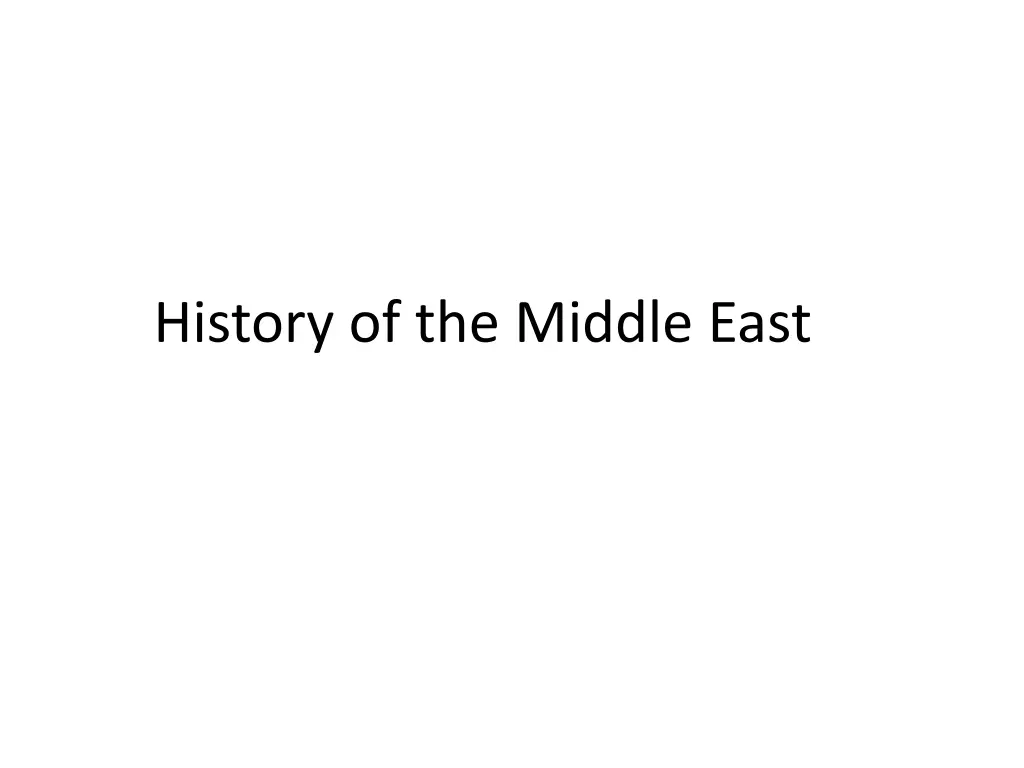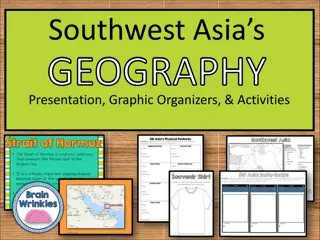
Understanding Modern Middle East Conflicts Through Historical European Partitioning
Explore the impacts of European partitioning in the Middle East post the Ottoman Empire breakup, leading to regional conflicts, including the historical reasons behind the establishment of Israel in 1948, conflicts driven by land and religion, and the US presence in Southwest Asia. Learn how new borders disrupted tribal unity and fueled ongoing tensions in the region.
Download Presentation

Please find below an Image/Link to download the presentation.
The content on the website is provided AS IS for your information and personal use only. It may not be sold, licensed, or shared on other websites without obtaining consent from the author. If you encounter any issues during the download, it is possible that the publisher has removed the file from their server.
You are allowed to download the files provided on this website for personal or commercial use, subject to the condition that they are used lawfully. All files are the property of their respective owners.
The content on the website is provided AS IS for your information and personal use only. It may not be sold, licensed, or shared on other websites without obtaining consent from the author.
E N D
Presentation Transcript
SS7H2a: Explain how European partitioning in the Middle East after the breakup of the Ottoman Empire led to regional conflict.
SS7H2b: Explain the historical reasons for establishment of the modern State of Israel in 1948; include the Jewish connection to the land, the Holocaust, anti-Semitism, and Zionism in Europe.
SS7H2c: Describe how land and religion are reasons for continuing conflicts in the Middle East.
SS7H2d: Explain U.S. presence and interest in Southwest Asia; include the Persian Gulf Conflict and invasions of Afghanistan and Iraq.
SS7H2a:The Ottoman Empire Was six times the size of Texas! Included what is now Turkey, parts of southeastern Europe, northern Africa, and southwestern Asia The empire had already lost some of its power and land before WWI Joined the losing side of WWI Britain and France divided up what was left over
SS7H2a: The (former) Ottoman Empire Britain Palestine (Israel) Saudi Arabia Iraq Jordan France Lebanon Syria
SS7H2a: Uh-oh! Britain and France drew new political borders that paid no attention local cultures and tribes (and the problems they had with each other!) Shia and Sunni Muslims were all lumped into Iraq together where they are still fighting each other for power The Kurds got divided between Turkey, Iraq, and Iran
SS7H2a: Problems New borders disrupted tribal unity France and Britain were happy with the divisions because it protected their own oil interests Middle Eastern countries did not want European countries in charge of them
SS7H2c: Conflicts in the Middle East (A TICKING TIME BOMB) CONFLICT between different religious (Sunni vs. Shia, Jew vs. Muslim)and ethnic groups (Kurds, Arabs, Persians, Semites) forms the modern history of the Middle East
SS7H2c: Conflicts in the Middle East Israel: created in 1948 Palestine denies its right to exist Israel was immediately attacked by Arab neighbors Israel won the war and expanded its Jewish territory Land in the region has been traded several times
SS7H2c: Conflicts in the Middle East Israel continued: Arab nations still do not recognize Israel as a country Almost constant conflict between Israelis and Palestinians in the Gaza Strip Israel has signed peace treaties with Egypt and Jordan but seems to always have conflict with Lebanon Hezbollah (party of God), Islamic Shiite group that frequently attacks Israel from Lebanon
SS7H2c: Conflicts in the Middle East Iran: 1979- fundamentalist Muslims took over the Iranian government Tried to remove all influence of Western Society Imposed a strict interpretation of Islamic law on the entire population of Iran
SS7H2c: Conflicts in the Middle East Iran-Iraq fought a war for eight years in the 1980s and 1990s over oil-rich territory No clear winner but it led to Iraq invading Kuwait in 1990 This started the Persian Gulf War (1990-1991)
SS7H2b: The Establishment of Israel The Jewish connection to the land: Ancient and Biblical home of Jews The sacred places of Judaism are there The Wailing (Western) Wall
SS7H2b: The Establishment of Israel Palestine was part of the Ottoman Empire Palestine captured by the British in 1918 Between 1919 and 1939, LOTS of Jews moved to Palestine to escape rising persecution in Europe (anti-Semitism) After the Holocaust and WWII, the United Nations voted to divide Palestine into Jewish and Arab states so the Jews could have a nation, too Israel became a nation on May 14, 1948
SS7H2b: Zionism Zionism: the movement to unite displaced Jews and settle them in Palestine Became popular in parts of Europe in the 1880s
SS7H2b: Zionism, a history 11thcentury B.C.- King Saul establishes the kingdom of Israel in the region of Palestine 586 B.C.- Jewish kingdom of Israel conquered by the Babylonians Strong tradition that Jews would be returned to their homeland
SS7H2b: Zionism, a history 70 A.D.- Romans destroy Jerusalem and the Jews scatter Other political events over the following centuries spread Jews throughout Asia, Europe, then North America Some Jews immigrated to Palestine but were a small minority there
SS7H2b: Zionism Britain worked with the Zionists during WWI Hoping to win Jewish support for the war Hoping to gain control of Palestine As more Jews moved to Palestine, Arabs felt threatened Britain backed off from supporting Zionism to appease the Arabs
SS7H2b: Anti-Semitism Anti- against Semite- the ethnic group of the Jews WHY? Semites are an inferior race?? The Jews killed Jesus???
SS7H2b: Anti-Semitism Some European countries did not allow Jews to own property Jews were restricted from attending college NAZIS- Hitler and his party took power in Germany in the 1930s Removed all protection of law for Jews
SS7H2b: The Holocaust Hitler wanted to rid the world of its Jewish problem Blamed Jews for Germany losing WWI Said Jews were an inferior race Fired Jews from government jobs Removed Jews from public schools Forbid Jews to own cars Seized Jewish property Stripped Jews of their German citizenship
SS7H2b: The Holocaust The Night of Broken Glass (November 9, 1938) Nazi mobs killed dozens of Jews Shattered windows on Jewish homes and businesses Set fire to every synagogue in Germany DEATH AND CONCENTRATION CAMPS .YOU KNOW HOW THIS STORY GOES 6 MILLION JEWS KILLED MEN, WOMEN, AND CHILDREN ENDED IN 1945 WITH THE CLOSE OF WWII
SS7H2d: The Persian Gulf War Iran-Iraq war had no clear winner so Iraq s president, SADDAM HUSSEIN, decided to pick on Kuwait Hussein said Kuwait should have been part of Iraq when France and Britain split the former Ottoman Empire (YES, that AGAIN!)
SS7H2d: The Persian Gulf War Hussein invades Kuwait in 1990 Kuwait is a member of the United Nations UN allies come to help Kuwait in Operation Desert Storm The war lasted only six weeks Lots of environmental damage done by setting oil wells on fire Iraq hints that it has WMDs
SS7H2d: The Persian Gulf War Weapons of Mass Destruction Iraq was ordered to destroy all chemical and biological weapons and stop making nuclear weapons UN inspectors entered Iraq in 1991 and destroyed these weapons until 1998 Many believed about 85 percent had been destroyed Others believed Hussein had hidden reserves of these weapons and secret production facilities
SS7H2d: Invasion of Afghanistan Meanwhile in Afghanistan In the 1990s, the extreme religious group called the Taliban was rising in power in Afghanistan The anti-American Taliban was thought to be sheltering the terrorist group Al Qaeda and its leader, Osama bin Laden
SS7H2d: Invasion of Afghanistan The US identified OSAMA BIN LADEN as the person responsible for the September 11, 2001 attacks on the World Trade Center and the Pentagon In November 2001, the US invades Afghanistan to find Osama bin Laden and disarm the Taliban
SS7H2d: Osama bin Laden and the Invasion of Afghanistan The Taliban was defeated and a new government was established The Taliban rebuilt its forces in Pakistan and launched new attacks on Afghanistan using suicide bombers, roadside bombs, and attacks on US/international military posts Osama bin laden was located in Pakistan and killed by the US military on May 2, 2011
SS7H2d: Back in Iraq After UN inspectors leave Iraq in 1998, some people still worried that Iraq had WMDs Saddam Hussein refused many requests from inspectors 2003, military forces from US, Britain, and others invade Iraq The government quickly fell and the military campaign was over in less than two months
SS7H2d: Back in Iraq Hussein was captured, tried, and sentenced to death Putting the country back together has been difficult A governing council was created while a constitution was written A guerilla fighting force attacked the occupying US forces These attacks are still ongoing while Iraqis try to establish and maintain their new democratic government






















